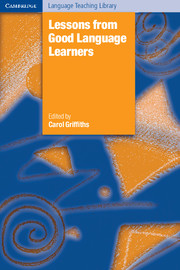Book contents
- Frontmatter
- Contents
- List of contributors
- Acknowledgements
- Editor's overview
- Prologue
- Reflections
- Part I Learner variables
- 1 Motivation and good language learners
- 2 Age and good language learners
- 3 Learning style and good laguage learners
- 4 Personality and good language learners
- 5 Gender and good language learners
- 6 Strategies and good language learners
- 7 Metacognition and good language learners
- 8 Autonomy and good language learners
- 9 Beliefs and good language learners
- 10 Culture and good language learners
- 11 Aptitude and good language learners
- Part II Learning variables
- The learners' landscape and journey: a summary
- Index
11 - Aptitude and good language learners
Published online by Cambridge University Press: 11 August 2009
- Frontmatter
- Contents
- List of contributors
- Acknowledgements
- Editor's overview
- Prologue
- Reflections
- Part I Learner variables
- 1 Motivation and good language learners
- 2 Age and good language learners
- 3 Learning style and good laguage learners
- 4 Personality and good language learners
- 5 Gender and good language learners
- 6 Strategies and good language learners
- 7 Metacognition and good language learners
- 8 Autonomy and good language learners
- 9 Beliefs and good language learners
- 10 Culture and good language learners
- 11 Aptitude and good language learners
- Part II Learning variables
- The learners' landscape and journey: a summary
- Index
Summary
In her paper on the good language learner, Rubin (1975) identified aptitude, motivation, and opportunity as three factors that account for differential success in language learning. With respect to aptitude, she argued that aptitude tests predict success but do not provide sufficient information to guide pedagogical decision making. Instead, she advocated focusing on the strategies used by good language learners. The celebration of the thirtieth anniversary of Rubin's paper provides an excellent vantage point to view the latest developments in language aptitude research and to revisit the issue of how the concept of aptitude can inform pedagogy.
What is aptitude?
The concept of aptitude current at the time Rubin wrote her paper was that of John Carroll (1962, 1981) who saw foreign language aptitude as a stable cognitive characteristic of those individuals who have a knack or talent for learning other languages. It is defined in terms of speed in language learning. The most widely used measure of aptitude today is still the Modern Language Aptitude Test – MLAT (Carroll and Sapon, 1958) which was designed in the post World War II period to select learners who would be best able to profit from short intensive language courses. It has proved to be a consistent predictor of learning outcomes in a wide variety of contexts (for instance, Carroll, 1981; Gardner and Lambert, 1972). However, despite its predictive utility, the MLAT later came to be devalued by teaching practitioners because of its association with the audiolingual method.
- Type
- Chapter
- Information
- Lessons from Good Language Learners , pp. 142 - 156Publisher: Cambridge University PressPrint publication year: 2008
- 3
- Cited by



